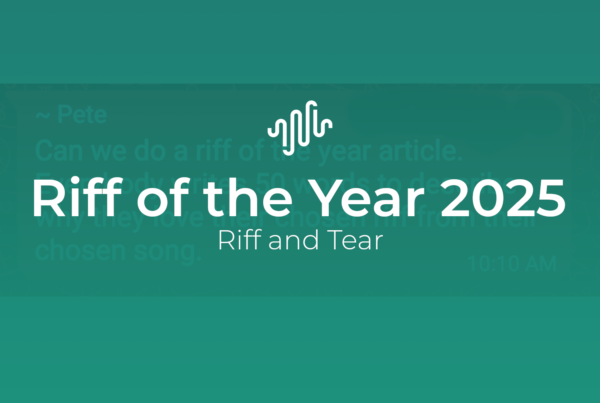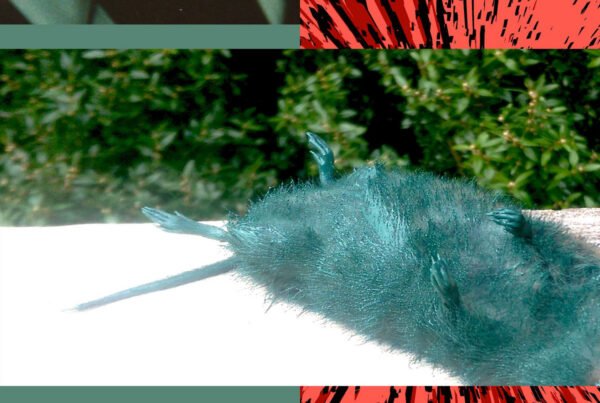A couple of weeks ago, Thrice released their newest album Horizons/East; (almost) 16 years ago, it was time for their first experimental foray Vheissu to see the light of day. While it’s definitely fulfilling to see bands like Thrice, who have shaped the adolescent explorations of many an EIN writer, still going strong in the present day, there’s also a right time for reflection, for the celebration of their past achievements; I’d say we’re due for the latter right about now.
To this end, I have compiled the thoughts of my dear colleagues Jake, Gary, and Alex on Vheissu, which signified Thrice embarking on a new, exciting trajectory away from their roots in the dual post-hardcore/emo scene of the early ’00s. Maybe you will find your own nostalgia mirrored in their statements.
Jake Walters
My personal story of Thrice’s Vheissu is, in many ways, the story of my love of music. 16 years ago I was slowly grasping for my musical identity as I was shedding the taste of my childhood and late teens and seeing what was out there for my ears. Remember: this was before the streaming music boom, and if there were any great sites like ours that shared musical recommendations every week, I was quite unaware of them. So, as was custom in that time, you bought an album based on either radio play, a friend’s recommendation, or just randomly scooped one up based on some sort of intuition. I don’t remember anything else about that day, or even about that year, but I do remember walking through the music section of my local department store and seeing that wild, somewhat incoherent album art, covered with unfamiliar phrases and icons. I was immediately curious. Who was Thrice? Were they sailors? What would this even sound like? I had far too many questions not to buy it. I wasn’t ready.
The pulsating tone that leads into “Image of the Invisible” was mimicking my anticipation when I pressed play, unsure what I would be hearing. The build, the anticipation, the pacing, the passion – it was all more than I could have imagined. It made me want to move and bounce my head around in a way that nothing ever had before, and this was just the first track. I had dabbled in the then-modern alternative scene, but nothing was hitting like this. Clever, meaningful lyrics, percussive pounding rhythms, and a variety of vocal approaches that were dynamic and intense. “The Earth Will Shake” literally shook me, it was the most intense thing I had heard up until that time, and frankly, that song is still massive to me. Following that song with “Atlantic” with its hypnotic rhythm, laid back beauty, and gorgeous arrangement is such a smart decision dynamically. The incorporation of the chimes, acoustic guitars, and Dustin’s vocals dreamily leading the song to it’s dramatic conclusion made for one of the most memorable tracks early on the record.
When it comes to memorable tracks, however, nothing comes close to “Hold Fast Hope” for me. Both then and now, the intensity and dynamics of this track resonate strongly with me. It also may be the heaviest song in Thrice’s catalog, but damn it’s a beauty. ‘How can you be sleeping/Waves like weapons crash/O’er us, cry for mercy and hold fast hope’ – nothing hits like that first line on the entire record, and it shook me to the core. Its there where this album clicked for me, and it’s still my favorite moment on the record. It’s passion and poetry put together in a package like I’d never heard, and I still go back to this song over and over again. Who am I kidding? I go back to this album a lot. There simply are no stinkers on Vheissu. “Like Moths to Flame” is a killer track near the end of the album, and the closer is maybe Thrice’s most played song ever, “Red Sky”.
While extolling this album’s mechanics is something I barely did, there really isn’t room for critique on them. Gorgeous instrumentation, lyrical prowess, dynamics for days, and Dustin’s impassioned rasp are all dolled out perfectly as this album unfolds. Vheissu is a comfortable collection of songs for me that is both timeless and nostalgic with unfathomable depth, wonder, and beauty.
Gary McDermott
2005 seemed a year of transition for many artists. The Mars Volta had already set their stall with Deloused in the Comatorium, but left any fragments of At The Drive-In well in the rear-view mirror with the further experimental Frances The Mute. Idlewild completed their transition from young punks to more accessible indie rock with the release of Warnings/Promises, whilst the mighty System of a Down seemed to close the door on their recording life with the dual release of Mezmerize and Hypnotize.
Thrice seemed intent on taking a similar path, bringing producer Steve Osborne on board to work on the follow-up to 2003’s The Artist In The Ambulance. Far from coming from a post-hardcore background, Osborne had been involved in a steady stream of softer releases from bands such as Doves and Elbow, indicating a possible change of direction for the band. For me, Thrice seemed to have reached their peak with The Artist In The Ambulance. A more polished sound and accessible songs such as “All That’s Left”, whilst still retaining the raw energy from earlier releases, introduced the band to a much larger audience. Vheissu arrived late in 2015 to put any thoughts that this band could not follow with a stronger release to bed.
As far as album openers go, “Image of The Invisible” is an absolute beast. This is classic Thrice – big drums, big guitars, and Dustin Kensrue’s raspy vocals. Yes, there were some minor changes to the style with the initial swirling synth and introductory morse code, but otherwise, this was the same band that had gripped me with their previous releases. As “Between The End And Where We Lie” kicks in, though, you release this is a new and re-energised Thrice. An almost Radiohead introduction with Philip Selway-inspired drums, this was a softer side to the band that we had seen only minor glimpses of prior to this. Aggression returns however for the majority of the track, with this subtle mix of the soft and loud providing the formula for the most part for the rest of the album.
The band, though, were clearly keen to showcase their abilities to write mellower pieces that didn’t require their trademark (to this point) noise. Songs like “Atlantic” and “Like Moths To Flame” drop the pace dramatically, slowly building upon a bed of electronics with only glancing looks towards the heavier nature of some of their other works. Still, the four-piece were not ready to fully leave behind what had made them so successful to this point, “Hold Fast Hope” being a prime example of a song that could have easily slotted in on The Illusion of Safety, no questions asked. But this was a band ready to change, ready to carve themselves a new path. The closing lyrics of the album, read with the knowledge of where Thrice have travelled in the almost 16 years since the release of Vheissu, read today almost like a prophecy.
‘Look and see the sky turn red
Like blood it covers over me
And soon the sea shall give up her dead
We’ll raise an empire from the bottom of the sea’
Much as with the release of The Artist In The Ambulance, Vheissu appeared to be a band at their absolute best. For me, it is this period that remains Thrice’s finest, the perfect blend of electronics and noise. I could find myself flicking through their back catalogue from time to time, but will always find a path back to the opening beeps and glitches of Vheissu.
Alex Sievers
September’s excellent Horizons / East, 2018’s wonderful Palms, and the experimental Alchemy Index series wouldn’t exist, not as they currently do, without Thrice first taking a leap of faith back in 2005. After their major-label debut with Artist in The Ambulance on Island, Thrice followed what was then their most accessible and successful work with a fresh, unexpected opus: Vheissu. In 2003, they were a well-written, lyrically thoughtful melodic post-hardcore act. And it was fucking sick. After touring that record hard and taking some R&R in 2004, they emerged in 2005 as a well-written, very thoughtful band, but one undergoing a meditative ‘Radiohead‘ moment, helped along by producer/engineer Steve Osborne. And it was fucking sick. Thrice’s self-reinvention over the years, starting here, is why I’ve loved them for so long; it’s why Vheissu has endured ever since.
Hardcore mannerisms remained, as per the hyperactive “Hold Fast Hope”, one of the more aggressive numbers from this era of Thrice (that’s really saying something given certain heavier cuts off the two previous records). So too remained their penchant for impressive rock choruses, as per “Image Of The Invisible” – an anthem for humanity, diversity, outcasts and the marginalized – would stand tall upon. The gargantuan “Like Moths to Flame” is often referred to as just ISIS worship, because it is an immense post-metal number – once the lo-fi piano gives way – that’s not shy about its influences and it really sticks the landing. An album of just songs like these would’ve been fine – good, even – but Thrice’s artistry ran deeper than that, and Vheissu was all the better for it.
Vheissu works because it’s a rock aesthetic and punk foundation boldly informed by other styles. The angular riffage, Dustin Kensrue’s screaming, their sonic punchiness and hooks didn’t go anywhere; there was just plenty more happening around these compositions now. Rhodes pianos and synths dot the dark rock number of “Between the End and Where We Lie”. Dreamy synths and electronic beats swim under the soft moody waves of “Atlantic”. There’s a Hammond organ wailing away on the slow stomper “The Earth Will Shake”, complete with a prison chain-gang chant that reflects the songs bluesy intro and The Prudent Jailer source material. “Music Box”? Inspired by an actual music box – its notes are heard in the background – that guitarist Teppei Teranishi bought while on tour in Japan, duh. On the back half rests a towering Thrice staple, the delay-soaked guitars and chilling atmosphere of “Of Dust And Nations”, forever embedding the refrain of ‘So put your faith in more than steel‘ into countless minds. Myself included.
16 years ago, few others in Thrice’s scene were referencing Bible verses in song names, having detailed album artwork quote lyrics from the songs within, using Morse code to spell out the album’s title, or pulling influences from ethnomusicologists (Alex Lomax) or authors (C.S. Lewis). In the hands of a lesser group, this experimentation would’ve just been throwing shit at a wall hoping it sticks. With Thrice’s expertise, a genuine classic of the alt-rock and post-hardcore universes was born because it dared to travel light years beyond what those descriptors mean; going beyond what they could sound like back in 2005. Vheissu was a bold moment where Thrice turned to their adoring audience and asked fans to join them on an ever-evolving journey. Their fans answered loudly and passionately; the rest is history. And so a record about the impermanence of our cities and nations, about the abstraction of our lives and free wills became, fittingly, timeless.







One Comment